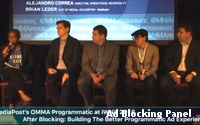 Is there a
connection between the rise of programmatic media-buying and the rapid adoption of digital ad-blocking technology by consumers? The opening panel discussion at OMMA Programmatic would seem to suggest
that is definitely the case.
Is there a
connection between the rise of programmatic media-buying and the rapid adoption of digital ad-blocking technology by consumers? The opening panel discussion at OMMA Programmatic would seem to suggest
that is definitely the case.
The main reason, said a panel of agency digital media experts, is that it has contributed to a decay in the consumer’s experience of digital media,
as publishers cram more inventory into pages and apps to generate more revenue.
While that makes sense for the supply side, Jesse Cahill, Essence digital head of media, said
it’s not without some aiding and abetting from the demand side.
“Programmatic makes it a lot easier for the bad behaviors of digital to become more pervasive and onerous
to consumers,” he said, citing the fact that programmatic “amplifies” negative practices with diminishing returns -- especially retargeting, which “hammers” consumers
“incessantly, without regard for frequency. Where you think you’re being relevant, you’re actually being irrelevant,” he charged.
advertisement
advertisement
Even more ironic is that
this is happening in the face of increasing media-buying efficiencies. Instead of utilizing the savings generated by programmatic to reinvest in smarter media or marketing, or even putting back on the
client’s bottom line, Cahill said the industry is just using cheaper programmatic pricing to increase its frequency.
“We’ve just bought more impressions,” he
said.
Another unintended consequence of the increasing efficiency of programmatic media-buying is that brands and agencies have shifted their spending into richer and more
bandwidth-hungry formats to engage consumers -- especially video.
The problem with that, said Steve Carbone, MediaCom chief digital and analytics officer, is that all those fat media
advertising files are increasingly being seen as an incursion by consumers, leading many to install ad blockers to avoid them.
“This is about an industry that created bad ads,
stacked them up and ate up your data plan,” he explained, adding, “consumers said, ‘enough!'”
Specifically, he said the “heaviness” of video files
is sucking consumers' data plans and also taking time away from the media experiences that brought them to digital media in the first place.
“This is costing me money. I have to wait for 15
ads to download,” he said, citing what he believes many ad-blocking consumers are thinking -- if not actually saying.